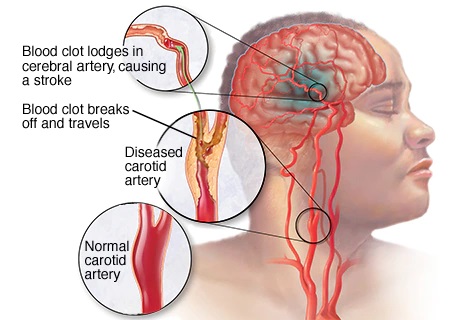- centre@esthersplacegh.com
- (+233) 050 572 1405
- Opening : Mon-Fri 09:00 - 18:00
Blog Update

Stroke is a layman’s term for a medical condition called cardiovascular accident. Stroke is the number 5 leading cause of death and disabilities in Ghana and the United States of America by WHO.
Stroke is a disease that affects the arteries leading “to and within” the brain.
For us to understand the cause of this disease, we need to know what an artery or arteries are.
Under this study, we will describe Arteries as Blood vessels that carry oxygenated blood to the brain from the heart. The brain needs a constant supply of blood, which contains the needed oxygen and nutrients to function. Specific arteries supply blood to specific areas of the brain.
A stroke occurs when the blood vessel that carries oxygen and nutrients to the brain is either blocked by a clot or bursts (ruptures). When this occurs, part of the brain cannot get the blood it needs, so it and brain cells die off.
The blockade in the arteries (blood vessel) is as a result of a plaque (fatty substance in the walls of the artery) or blood clot.
This blockade slows down the flow of blood to the brain and accidentally causes that portion of the brain to die off. The blockade also build pressure within the arteries and causes the blood vessel to bulge up and later burst or rupture therefore preventing blood to the brain.
Types of stroke
Stroke can be grouped into types depending on how it occurs.
Note: much emphasis will be placed on the types of cardiovascular accident in our subsequent write-ups.
Effect of stroke
The effects of a stroke depend on several factors, including the location of the obstruction and how much brain tissue is affected. However, because one side of the brain controls the opposite side of the body, a stroke affecting one side will result in neurological complications on the side of the body it affects
The brain is divided into left and right hemisphere.
Left hemisphere
If the stroke occurs in the left side of the brain, the right side of the body will be affected, producing some or all of the following:
Paralysis on the right side of the body
Speech/language problems
Slow, cautious behavioral style
Memory loss
Right hemisphere
If the stroke occurs in the right side of the brain, the left side of the body will be affected, producing some or all of the following:
Paralysis on the left side of the body
Vision problems
Quick, inquisitive behavioral style
Memory loss
Note:
When stroke occurs in the brain stem, depending on the severity of the injury, it can affect both sides of the body and may leave someone in a ‘locked-in’ state. When a locked-in state occurs, the patient is generally unable to speak or achieve any movement below the neck.
Symptoms of stroke:
If any of these symptoms persist, do not be in despair, Contact us on +233505721405 or locate us at E6, Ashaley Botwe Nmai Dzorn Road, Adenta Ritz Junction.
At ESTHER’S PLACE WELLBEING HUB, we design a treatment modality such as Psychological, Nutritional and Physiotherapy aid to avert and improve the degree of damage caused to the body.
We also help to prevent future occurrence of stroke after going through an assessment to determine if there is any possibilities.
Esther’s Place Well-being Hub, we make healthcare accessible and affordable to all, especially the aged.
At Esthers Place, we are committed to providing our clients with the highest quality care and support.
WhatsApp Us